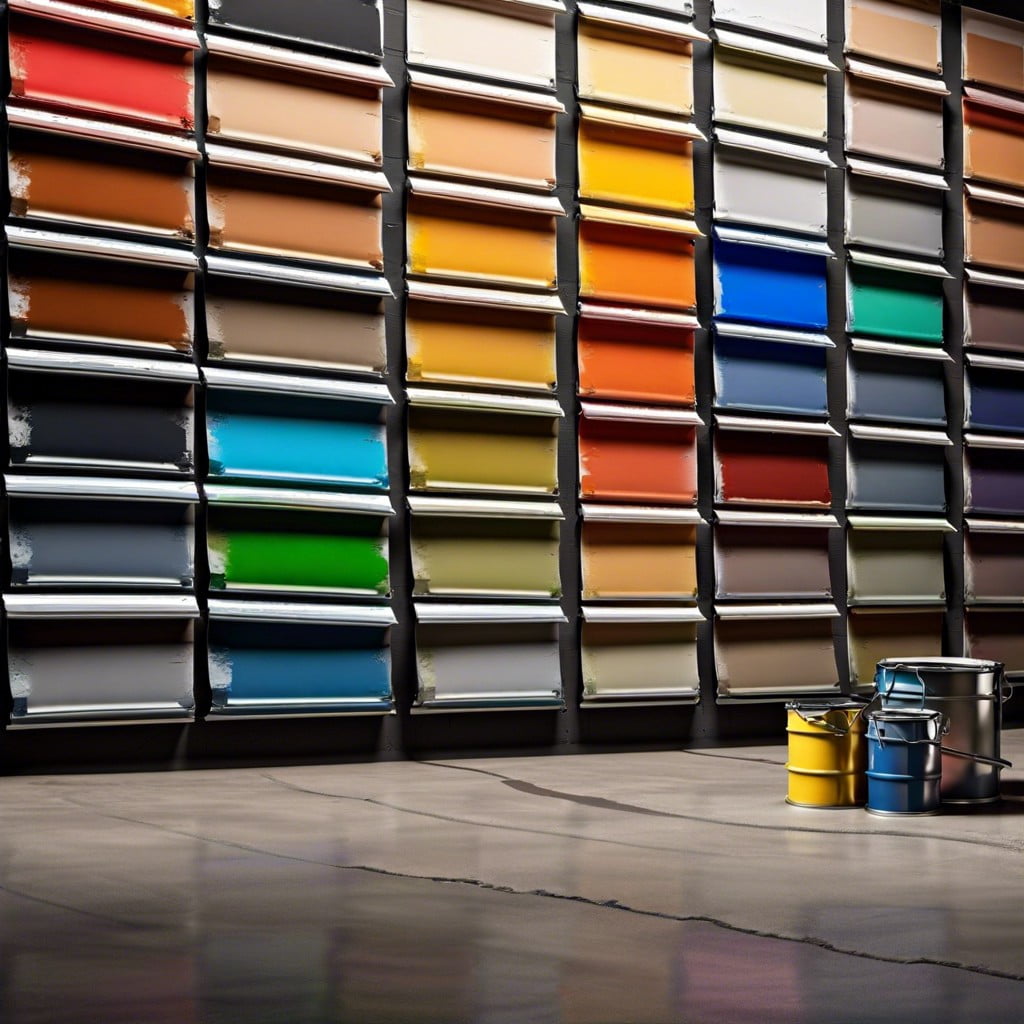Discover the ideal paint options for your garage walls, focusing on durability and finish quality to elevate your space.
Key takeaways:
- Consider climate, daily activities, wall material, and lighting.
- Factors affecting paint selection: environment, lighting, wall material, durability, health implications.
- Two main contenders: latex paint and epoxy paint.
- Latex paint is user-friendly and quick-drying, while epoxy paint is durable and resistant to stains.
- Latex paint is breathable, minimizes the risk of cracks, and has lower VOC levels.
Considerations to Make When Picking the Best Paint for Garage Walls

Before diving into the paint aisle, consider the climate in your garage. Is it mostly hot or cold? Does moisture collect on the walls? A paint that resists mildew and mold is wise if humidity is your uninvited guest.
Next, think about the daily activities. Will cars be parked, creating exhaust fumes, or is it a workshop where spills and splatters are part of the charm? Some paints make cleaning up a breeze – a dab of soap, a splash of water, and voilà, good as new.
Also, ponder the existing wall material. Drywall and concrete have different needs. A paint that’s friends with drywall might give concrete the cold shoulder.
Lastly, let’s talk light. Is your garage a cave or does it bask in sunlight? Glossy finishes bounce light around, while flat matte keeps it cozy. Light colors open up spaces; darker hues create a snug hideaway.
When you match the paint to your garage’s personality, those walls won’t just be surfaces; they’ll be sidekicks to your daily hustle.
Factors Affecting Paint Selection
The garage environment plays a critical role in determining the ideal type of paint. Environments that experience frequent temperature fluctuations or high humidity levels call for paints with resilience to prevent peeling and mold growth.
Lighting is another variable; garages with limited natural light need paint that reflects artificial lighting well to keep the space bright.
Consider the wall material—whether it’s drywall, concrete, or brick, each surface may adhere better to different paint formulations.
Durability is key, especially in a garage which often doubles as a workshop or storage area. Paints that can withstand frequent cleaning and resist oil stains, and scuffs are crucial for longevity.
Lastly, think about the paint’s health implications. Volatile Organic Compounds (VOCs) in some paints can affect air quality, so options with lower VOCs are preferable for enclosed spaces such as garages.
Paint Types for Durability and Maintenance
When your garage walls need a fresh coat of paint, two main contenders stand out, each with its strengths. Latex paint is a popular choice due to its user-friendly nature. It dries quickly, emits fewer odors, and cleans up with water, making for a straightforward weekend project. It’s forgiving on imperfect surfaces and allows for touch-ups when your garage walls get dinked or scratched. On the flip side, if your garage doubles as a workshop, consider epoxy paint. It’s tougher than a two-dollar steak and perfect for standing up to grease, oil, and a host of other stains. While it takes a bit more elbow grease during application and clean-up, this champion in durability makes it a go-to for high-traffic garages. Keep in mind, some patience is necessary as it requires more time to set completely. Remember, a garage is not just for parking; it’s a high-use space, so choosing a paint that can roll with the punches will keep it looking sharp for years to come.
The Best Types of Paint for Garage Walls
Latex paint often stands out as an ideal choice for garage walls due to its easy application and quick drying time. Boasting a forgiving nature, it’s a godsend for the DIY painter tackling weekend projects. You’ll appreciate its resilience; it stands up to regular cleaning without the paint job losing its lustre.
For those fighting a never-ending battle against stains and chemicals, epoxy paint is the heavyweight champion. This water-resistant warrior creates a hard, slick surface that laughs in the face of oil spills and resists mold like a champ. The application may be a bit more involved, but the payoff is a surface that maintains its finish even when life throws it a curveball.
When you’re juggling cans at the hardware store, remember: a sheen can do wonders. Satin or semi-gloss finishes aren’t just about aesthetics; they make cleanup as breezy as a Sunday drive. Dirt and grime don’t stand a chance against a wall coated with the right finish.
So, grab a brush, a can of stamina, and your choice of armor for those walls. Whether it’s latex’s user-friendly charm or epoxy’s tough-as-nails attitude, your garage walls have met their match.
Latex Paint: Properties and Benefits
A popular choice for interior surfaces, including garages, is latex paint. Its water-based formulation makes it a cinch to work with. Cleanup involves just soap and water, taking the hassle out of post-painting chores. Most importantly, latex paint dries quickly, allowing for a faster return to your garage projects or storage reorganization.
Latex isn’t just about convenience though. With its breathable nature, it reduces the risk of trapping moisture in the walls, which can lead to mold and mildew. Additionally, thanks to its elasticity, it fares well with temperature fluctuations—typical in garage environments—minimizing the risk of cracks.
For those interested in maintaining a healthy space, latex paints often have lower levels of volatile organic compounds (VOCs). This means fewer odors and a safer painting experience overall. Plus, it’s available in a multitude of finishes, making it versatile for different looks and functional needs. Matte finishes can conceal imperfections, while semi-gloss options make for an easier-to-clean surface when inevitable scuffs and stains occur.